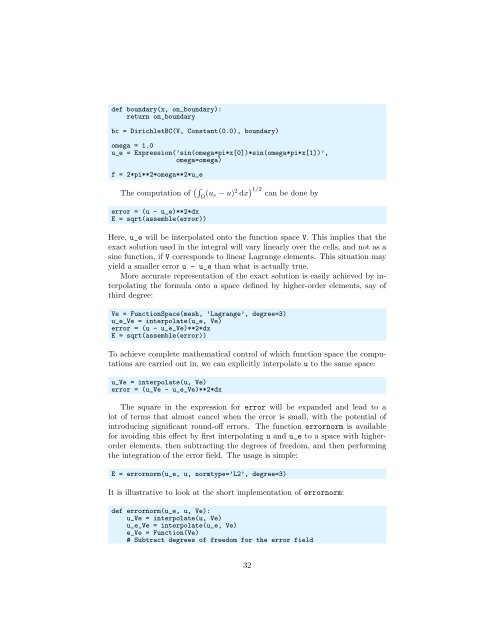A FEniCS Tutorial - FEniCS Project
A FEniCS Tutorial - FEniCS Project
A FEniCS Tutorial - FEniCS Project
You also want an ePaper? Increase the reach of your titles
YUMPU automatically turns print PDFs into web optimized ePapers that Google loves.
def boundary(x, on_boundary):<br />
return on_boundary<br />
bc = DirichletBC(V, Constant(0.0), boundary)<br />
omega = 1.0<br />
u_e = Expression(’sin(omega*pi*x[0])*sin(omega*pi*x[1])’,<br />
omega=omega)<br />
f = 2*pi**2*omega**2*u_e<br />
The computation of (∫ Ω (u e −u) 2 dx ) 1/2<br />
can be done by<br />
error = (u - u_e)**2*dx<br />
E = sqrt(assemble(error))<br />
Here, u_e will be interpolated onto the function space V. This implies that the<br />
exact solution used in the integral will vary linearly over the cells, and not as a<br />
sine function, if V corresponds to linear Lagrange elements. This situation may<br />
yield a smaller error u - u_e than what is actually true.<br />
More accurate representation of the exact solution is easily achieved by interpolating<br />
the formula onto a space defined by higher-order elements, say of<br />
third degree:<br />
Ve = FunctionSpace(mesh, ’Lagrange’, degree=3)<br />
u_e_Ve = interpolate(u_e, Ve)<br />
error = (u - u_e_Ve)**2*dx<br />
E = sqrt(assemble(error))<br />
To achieve complete mathematical control of which function space the computations<br />
are carried out in, we can explicitly interpolate u to the same space:<br />
u_Ve = interpolate(u, Ve)<br />
error = (u_Ve - u_e_Ve)**2*dx<br />
The square in the expression for error will be expanded and lead to a<br />
lot of terms that almost cancel when the error is small, with the potential of<br />
introducing significant round-off errors. The function errornorm is available<br />
for avoiding this effect by first interpolating u and u_e to a space with higherorder<br />
elements, then subtracting the degrees of freedom, and then performing<br />
the integration of the error field. The usage is simple:<br />
E = errornorm(u_e, u, normtype=’L2’, degree=3)<br />
It is illustrative to look at the short implementation of errornorm:<br />
def errornorm(u_e, u, Ve):<br />
u_Ve = interpolate(u, Ve)<br />
u_e_Ve = interpolate(u_e, Ve)<br />
e_Ve = Function(Ve)<br />
# Subtract degrees of freedom for the error field<br />
32

















